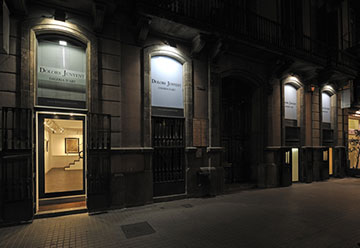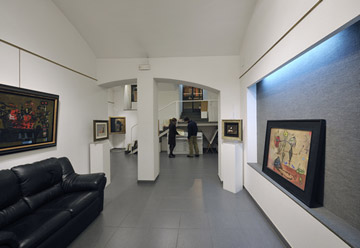- Amat, Frederic
- Amat, Gabriel
- Arranz Bravo
- Arroyo
- Barbara
- Barcelo
- Bartolozzi
- Bea
- Becquer
- Benet
- Bird
- Bores
- Brinkmann
- Brossa
- Cardenas
- Carral
- Casas
- Castillo
- Chancho
- Clave
- Corbero
- Corneille
- Croft
- Cuixart
- Domingo
- Fabres
- Farreras
- Feito
- Fenosa
- Forteza
- Genovart
- Gimeno
- Gonzalez
- Gonzalo
- Graner
- Granyer
- Grau
- Grau Sala
- Gudiol
- Guinovart
- Hernandez Mompo
- Hernandez Pijuan
- Jorn, Asger
- Junyent, Oleguer
- Lam
- Llena
- Lloveras
- Lopez Ramon
- Marin
- Marsans
- Marti Alsina
- Matilla
- Meifren
- Menchu Gal
- Meseguer
- Mir
- Mira
- Miro
- Moore
- Moragas
- Munoz
- Noland
- Olive
- Palazuelo
- Palencia
- Pazos
- Perejaume
- Perez Villalta
- Picasso
- Plasencia
- Plensa
- Ponç
- Puig
- Rafols Casamada
- Ramis
- Rasero
- Rebull
- Riera i Arago
- Rivera
- Roca Sastre
- Roig Soler
- Rossell
- Rueda
- Saura
- Serra
- Sicilia
- Solano
- Subirachs
- Sunyer
- Tamayo
- Tapies
- Tharrats
- Togores
- Torner
- Torres Garcia
- Ubeda
- Ucles
- Valdes
- Valls
- Vedova
- Viladecans
- Vilagrasa
- Zao Wou-ki
Artists +
Hours
Mallo, Cristino
BIOGRAPHY OF CRISTINO MALLO:
Cristino Gómez González was born in Tui in 1905 but soon moved to the Asturian city of Avilés due to his father’s professional reasons. It was there that he began his artistic education by attending the School of Arts and Crafts, showing an interest in sculpting, much like his sister, the painter Maruja Mallo.
In 1923, he moved to Madrid and decided to enroll in the San Fernando Fine Arts School. Later, Mallo studied at the School of Arts and Crafts. During his student years, he frequented the Museum of Artistic Reproductions and strolled through Madrid’s cemeteries, admiring the sculptures on the tombs. In 1927, he completed his studies with outstanding grades.
He regularly attended the gatherings at Café Gijón or La Granja del Henar, where he befriended figures such as Miguel Hernández, Dalí, Lorca, or Cela. During these years, Mallo worked on making models for various architects.
In 1929, he received his first significant commission: a commemorative plaque for Manuel Ventura Figueroa, the founder of the Royal Hospital of Santiago de Compostela.
In 1933, he received the National Sculpture Prize for his magnificent work in white marble, "Nude in Fish," which is now owned by the Reina Sofía National Museum.
Mallo moved to Salamanca in 1935 to teach linear drawing at the School of Arts and Crafts, where he met the painter Solana, who became a close friend, as well as Miguel de Unamuno.
During the Spanish Civil War, he belonged to the Alliance of Antifascist Intellectuals, collaborated on the magazine El mono azul, and participated in the staging of the play "Los títeres de Cachiporra." He was assigned to the Cartography School of Burjassot but preferred to go into combat on the Republican side as a lieutenant. Eventually, Mallo fell ill with bronchitis and was admitted to the Hospital of Valencia. Upon leaving the hospital, he was arrested and spent eight months in prison on charges of aiding the rebellion.
He lost his teaching position and dedicated himself exclusively to sculpture, working in the Madrid studio he shared with Francisco Arias until he returned to teaching in 1966 at the School of Arts and Crafts in the capital, where he taught for six years.
In 1973, Mallo was elected a full member of the Royal Academy of San Fernando, a position he declined in 1980.
He received the Gold Medal of Fine Arts in 1983, which crowned a life full of awards for his artistic work. He died in Madrid at the age of 84.
Mallo’s sculptural career developed within the figurative realm and can be divided into two well-defined stages: a first phase where he approached realism with life-sized carvings and a second phase where he created small-format pieces with great expressive capacity, highlighting the introduction of everyday and popular themes.




